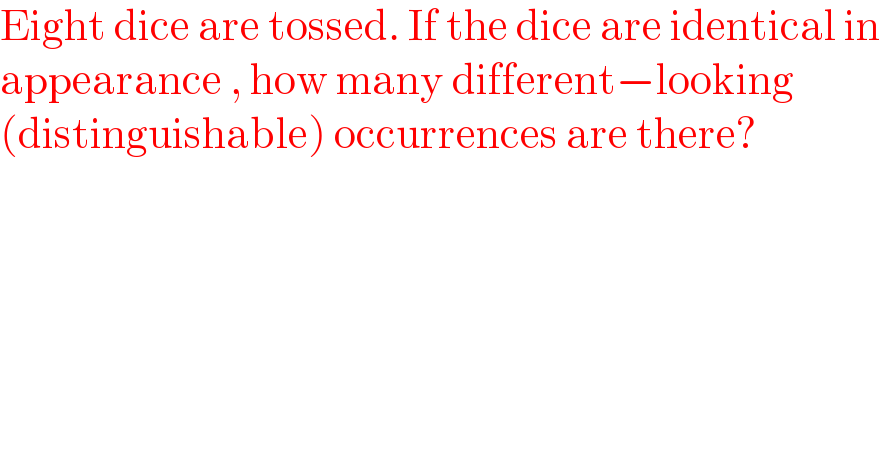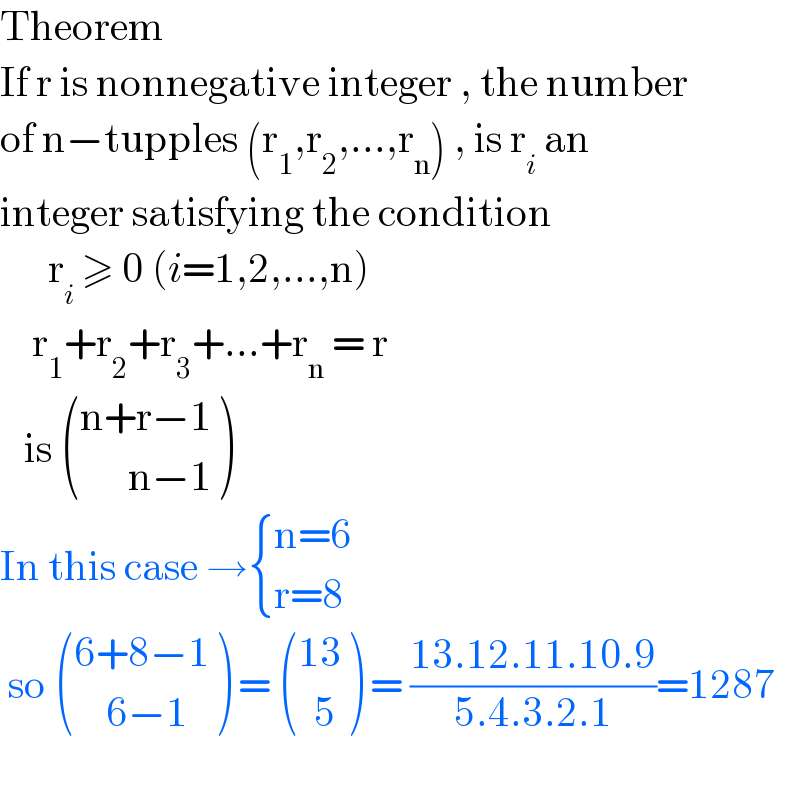Question Number 134389 by EDWIN88 last updated on 03/Mar/21

$$\mathrm{Eight}\:\mathrm{dice}\:\mathrm{are}\:\mathrm{tossed}.\:\mathrm{If}\:\mathrm{the}\:\mathrm{dice}\:\mathrm{are}\:\mathrm{identical}\:\mathrm{in} \\ $$$$\mathrm{appearance}\:,\:\mathrm{how}\:\mathrm{many}\:\mathrm{different}−\mathrm{looking}\: \\ $$$$\left(\mathrm{distinguishable}\right)\:\mathrm{occurrences}\:\mathrm{are}\:\mathrm{there}? \\ $$
Answered by bramlexs22 last updated on 03/Mar/21

$$\mathrm{Theorem}\: \\ $$$$\mathrm{If}\:\mathrm{r}\:\mathrm{is}\:\mathrm{nonnegative}\:\mathrm{integer}\:,\:\mathrm{the}\:\mathrm{number}\: \\ $$$$\mathrm{of}\:\mathrm{n}−\mathrm{tupples}\:\left(\mathrm{r}_{\mathrm{1}} ,\mathrm{r}_{\mathrm{2}} ,…,\mathrm{r}_{\mathrm{n}} \right)\:,\:\mathrm{is}\:\mathrm{r}_{{i}} \:\mathrm{an}\: \\ $$$$\mathrm{integer}\:\mathrm{satisfying}\:\mathrm{the}\:\mathrm{condition}\: \\ $$$$\:\:\:\:\:\:\mathrm{r}_{{i}} \:\geqslant\:\mathrm{0}\:\left({i}=\mathrm{1},\mathrm{2},…,\mathrm{n}\right) \\ $$$$\:\:\:\:\mathrm{r}_{\mathrm{1}} +\mathrm{r}_{\mathrm{2}} +\mathrm{r}_{\mathrm{3}} +…+\mathrm{r}_{\mathrm{n}} \:=\:\mathrm{r}\: \\ $$$$\:\:\:\mathrm{is}\:\begin{pmatrix}{\mathrm{n}+\mathrm{r}−\mathrm{1}}\\{\:\:\:\:\:\:\mathrm{n}−\mathrm{1}}\end{pmatrix} \\ $$$$\mathrm{In}\:\mathrm{this}\:\mathrm{case}\:\rightarrow\begin{cases}{\mathrm{n}=\mathrm{6}}\\{\mathrm{r}=\mathrm{8}}\end{cases} \\ $$$$\:\mathrm{so}\:\begin{pmatrix}{\mathrm{6}+\mathrm{8}−\mathrm{1}}\\{\:\:\:\:\mathrm{6}−\mathrm{1}}\end{pmatrix}\:=\:\begin{pmatrix}{\mathrm{13}}\\{\:\:\mathrm{5}}\end{pmatrix}\:=\:\frac{\mathrm{13}.\mathrm{12}.\mathrm{11}.\mathrm{10}.\mathrm{9}}{\mathrm{5}.\mathrm{4}.\mathrm{3}.\mathrm{2}.\mathrm{1}}=\mathrm{1287} \\ $$$$ \\ $$
